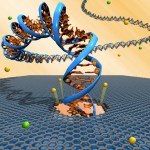radiocarbon
Photo of a Greenland shark from Wikipedia.
A multi-national team of scientists sought to determine the age of Greenland sharks (Somniosus microcephalus). These animals grow rather slowly (about 1cm per year) and are the largest fish in the arctic (>500 cm long), but their longevity was not yet known. The team used radiocarbon dating of crystalline proteins found within the nuclei of the eye lens. Because these proteins are formed prenatally, they offer a rather accurate way to estimate an animal's age. Their findings, published in Science…
When I was an undergrad in 1990 we were taught that all six periods of the Scandinavian Bronze Age were 200 (or in one case 300) years long. The most recent radiocarbon work shows that they all had different lengths and were more likely 130-280 years long. And the periods with the most abundant metalwork finds, II and V, are the two shortest. So their previously known status as metal-rich eras looks even more pronounced now, and the intervening periods look even poorer.
Per. I. 1700-1500 cal BC (200 yrs)
Per. II. 1500-1330 (170 yrs)
Per. III. 1330-1100 (230 yrs)
Per. IV. 1100-950/20 (165 yrs…
"Life exists in the universe only because the carbon atom possesses certain exceptional properties." -James Jeans
Here on Earth, every living thing is based around four fundamental, elemental building blocks of life: hydrogen, oxygen, nitrogen and, perhaps most importantly, carbon.
Image Credit: Robert Johnson / University of Pennsylvania.
From diamonds to nanotubes to DNA, carbon is indispensable for constructing practically all of the most intricate structures we know of. Most of the carbon in our world comes from long-dead stars, in the form of Carbon-12: carbon atoms…
